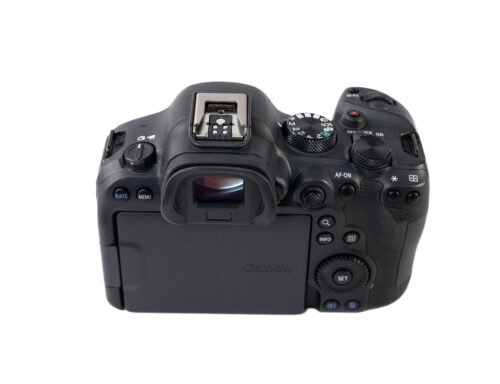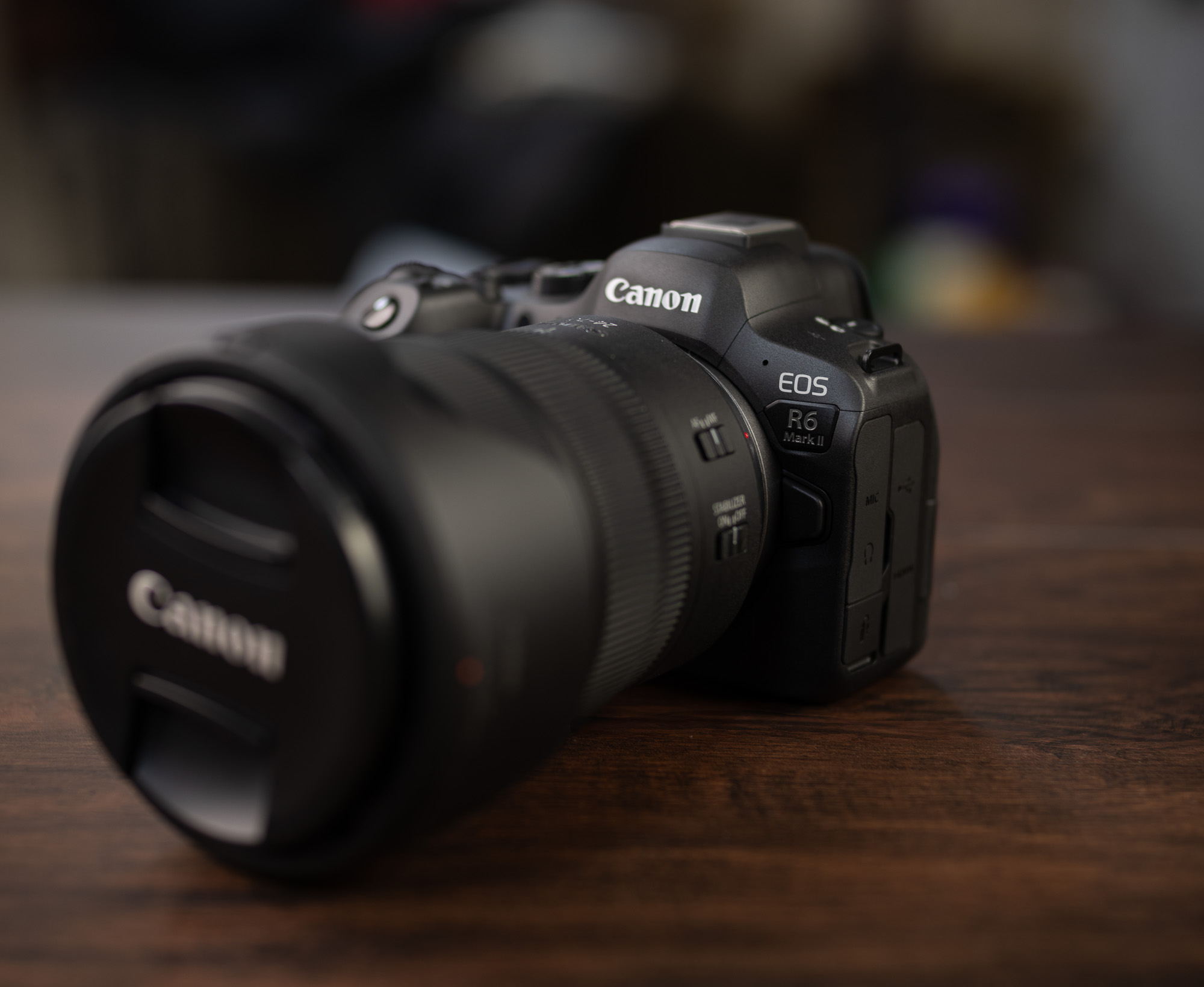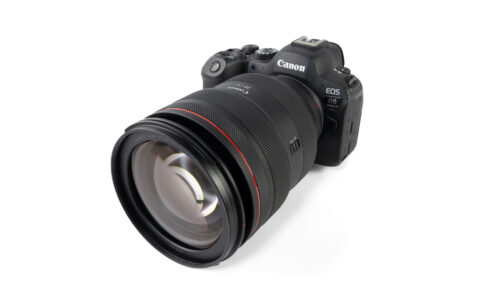SPECIFICATIONS
Here are the specifications of the new Canon R6 Mark II:
- 24.2 megapixel full-frame CMOS sensor.
- Continuous shooting at 12fps with mechanical shutter / 40fps with electronic shutter
- DIGIC X image processor
- 6K video recording at 60 fps, including ProRes RAW output with external storage medium
- 1080p at 180 fps
- 100% autofocus coverage
- 1,053 autofocus points
- Built-in image stabilization rated to 8.0 stops
- People, animal, and vehicle AF subject detection
- 4K/60p video (oversampled from 6K)
For the sake of comparisons, here are the specifications of the original Canon R6:
- Sensor: 20.1MP 35mm format CMOS
- Lens system: RF-mount
- Weatherproof: Yes
- Internal Stabilisation: Yes (5-axis)
- Autofocus: Dual Pixel CMOS AF II with 6,072 points
- Continuous shooting: 12fps, or 20fps with e-shutter
- ISO Sensitivity: 100 – 102400 ISO (pull 50, push up to 204800)
- Shutter Speeds: 1/8000s to 30s, Bulb
- Video: 3840 x 2160 @ 60p / 230 Mbps, MOV, H.264, Linear PCM
By the time the R6 Mark II was released, I already had the R5. Fans of ThruMyLens know that I very much like to shoot with two cameras and the great thing about the R5 and the R6 is that images they produce are virtually indistinguishable from one another. Yes, there’s a big difference in megapixels, but when you output the files to .jpg for articles or social media, you’d be hard pressed to identify images produced by the R5 vs the R6. Truth be told, it was probably silly for me to spend the money on the R5 (as opposed to getting a second R6). The R5 does have a few useful differentiating features I do use from time to time, but 90% of my needs are covered by the R6. I will say that it never sat well with me that upgrading from the 5D Mark IV to the R6 meant I had 6 less megapixels to work with as the 5D Mark IV had 30 megapixels.
At first glance, the Canon EOS R6 Mark II looks quite similar to the original R6. One notable change in the design is the repositioning of the power switch to the right-hand side of the top plate, replacing it with a stills/video mode lever on the left. This new layout makes it easier to switch between photo and video modes. However, for those of us that have muscle memory developed from years of using the previous R cameras, it will initially drive you nuts. Turning On/Off power has shifted from your left thumb, to your right index finger. I go to switch the camera on and I change from video to photo mode. If I’m looking at the camera, it looks like I can switch off with my right thumb. Oh no. That’s still the dial for ISO. The On/Off switch is actually best accessed by the right-hand index finger. Change is hard.

The backside of the R6 Mark II. Note the placement of the On/Off switch on the right, and the new Camera/Video switch on the left.
The 3.69-million-dot electronic viewfinder (EVF) and the fully articulating 3.0-inch LCD screen remain unchanged. If you would have asked me before I did this review if there was a discernable difference between the EVF and LCD screen on the R5 and the R6, I would have said “no.” I switch back and forth using these two cameras all the time – it’s just not something I notice. The R5 is better than both the R6 and R6 Mark II in this regard but I’m more than OK with the EVF and LCD on the R6/R6 Mark II.
Megapixel count increases slightly to 24.2MP. Auto focus and frame rate are quite similar to the much more expensive Canon R3. Mechanical shutter performance remains at 12FPS on both the R6 and the R6 Mark II, but electronic shutter performance doubles output to a blistering 40FPS on the R6II. This is probably one of the areas where an old DSLR shooter like me has a hard time grasping. When I was doing sporting event photography professionally, it was with cameras that shot 4-6 frames per second. 10 FPS was crazy fast and only available on Canon’s top tier 1D line of cameras. So I’m well satisfied with the 12 frames per second I get with the mechanical shutter on both of these cameras. There’s also a dynamic range hit that you take when you go into electronic shutter Mode to increase the frame rate to 40 FPS. I’m not covering a lot of sporting events these days, so this feature isn’t particularly important to me. It also features improved deep learning AI subject tracking. You can choose subject types manually or leave the camera to decide what it’s looking at. You can set left or right-eye tracking, and if the eyes can’t be detected the R6 II will switch to the face; if that’s hidden it will switch to head detection, and if that’s not possible is will recognize the subject’s body. Both the Canon EOS R6 Mark II and the EOS R3 utilize Canon’s Dual Pixel CMOS AF II system, which is renowned for its speed and accuracy…but my rate was already stellar on the R5/R6 so again I didn’t see a compelling reason from me to upgrade based on my use case.
The one area where the R6II does make me a little jealous was video performance. The R6II offers 6K ProRes RAW output via HDMI to an external recorder. I do all my video editing on an M1 MacBook Pro that optimized to handle ProRes files. The only downside is the need for an external recorder, so I decided to wait for the R5 Mark II to try this feature, which I assume will have similar capabilities without needing an external recorder since it should be able to output to CF Express Type B whereas the R6 and R6II both only offer dual SD card slot.
My feeling is that the R6 Mark II wasn’t necessarily designed to make most R6 owners upgrade. Instead, it was made to provide a more competitive option in the marketplace at this price point. The R6 II a much more compelling camera for hybrid stills/video photographers looking for its particular brand of speed and versatility in this price range. And Canon has read the market well because the R6 Mark II is Canon’s best selling camera body. Clearly I’m late to the game with this review – the R6M2 has been out nearly two years. In fact, with the recent release of the Nikon Z6 III, there’s a lot of pressure on Canon to get an R6 Mark III announced and out the door. In the last week we’ve even seen rumored initial specifications for the R6 Mark III. I initially thought that the differences between the R6 and R6 Mark II just weren’t compelling enough for me to upgrade, BUT…after spending time with the review unit I received, I did go ahead and trade in my R6. Why? Well earlier in the review I talked about the differences between the R6 and the R6M2 with the placement of the power On/Off switch and how it drove me nuts while I was using my R5 along side R6M2. I was constantly hitting the wrong switch on both cameras when I was trying to turn them on or off. This could be a real problem in a dynamic shooting situation where you need to react quickly. Knowing this, and knowing that I have pre-ordered the R5 Mark II (which uses the same power switch setup as the R6MII, I decided it was a good idea to go ahead trade in my R6.
The retail price of the Canon EOS R6 Mark II tends to vary a bit because Canon seems to always have some level of instant rebate available. The MSRP is $2499.00. As of this publication date, Canon is offering a $200.00 instant rebate, but for a short time Canon offered a $500.00 instant rebate. That brings the price down to $1999.00 – which is the price I paid, minus the nearly $900.00 I got in trade for my R6. With tax, that brought my upgrade cost to only about $1200.00.



0 Comments